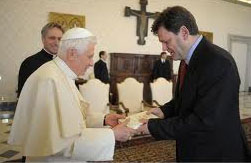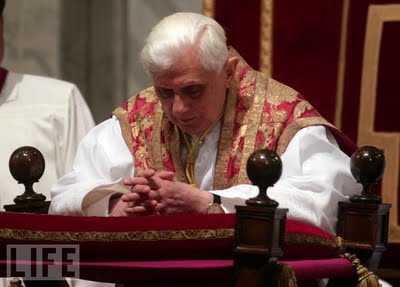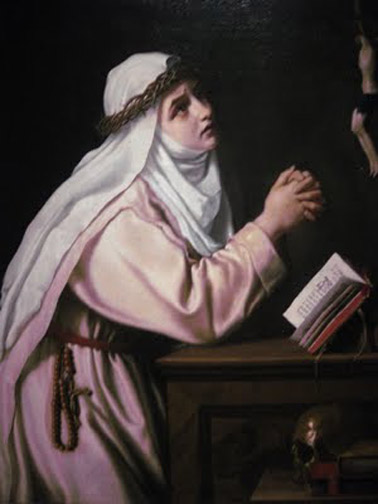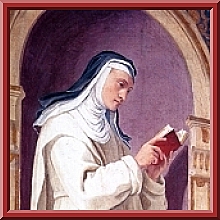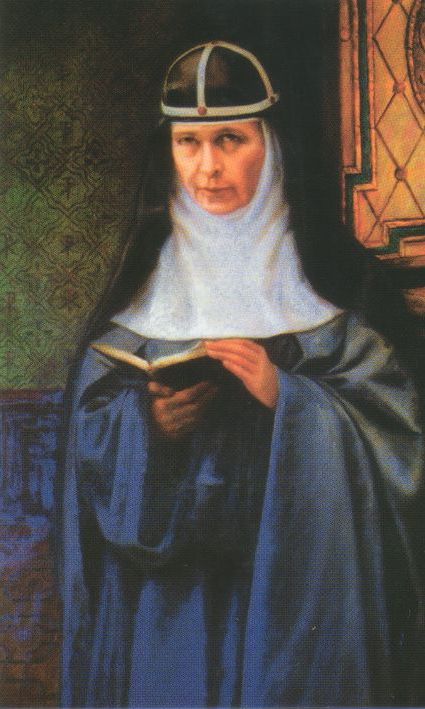Episode 3 – Regnum Novum: Bringing forth the New Evangelization through Catholic Social Teaching with Omar Guiterrez -Value # 3 – Look , Judge, Act 
Discerning Hearts is blessed to present Omar F. A. Guiterrez, M.A. , Special Assistant  to Archbishop George Lucas of the Archdiocese of Omaha, in a groundbreaking series which breaks open the heart of Catholic Social Doctrine.
We encourage you to visit “Regnum Novum – A New Kingdom: A Revolution†Omar Guiterrez’s blog site
 We live at a very special time. The confluence of many things has brought forth the clear need to be able to articulate the Social Teaching of the Catholic Church in a way that is accessible and applicable. This is not to be an effort where high-minded theories are to be bandied about. Rather, this is a time of opportunity wherein we can apply the Social Doctrine to the concrete so as to bring about a New Kingdom, a Revolution. – Omar G. from Regnum Novum
We live at a very special time. The confluence of many things has brought forth the clear need to be able to articulate the Social Teaching of the Catholic Church in a way that is accessible and applicable. This is not to be an effort where high-minded theories are to be bandied about. Rather, this is a time of opportunity wherein we can apply the Social Doctrine to the concrete so as to bring about a New Kingdom, a Revolution. – Omar G. from Regnum Novum
[powerpress]
3.  Look, Judge, Act
Blessed Pope John XXIII gave us this practical suggestion in his letter Mater et magistra. The Social Doctrine provides us with principles for reflection, criteria for judgment, and directives for action. Social justice is supposed to be lived out in our every day. That’s the point, and so this Holy Father gave us the paradigm.
Look at the world around you, that which is most immediate to you. Start with your family. Proceed to your culture. Witness the social and economic realities/policies near you. Know the political landscape of your city, county, state, and nation. See your neighbors close at hand and around the world. Use the principles of the Social Teaching as you look so that you know what to look for.
Judge what is best for the family, for the culture, for the society and the economy, for the state, for the world. Use the criteria provided by the Social Doctrine. What is missing? Why is it missing? What can be done?
Act on it. You’re a lay person with as real an obligation to evangelization as any priest. Do something in the world so as to make it’s semblance more like that which the Lord desires. Volunteer. Participate. Pray. Do not let some tell you that prayer is not action. Pray. You can pray and raise good children.
Also visit Omar’s “Discerning Hearts†page Catholic Social Teaching 101
Tags: catholic, catholic podcast, catholic prayer, catholic social doctrine, catholic social teaching, cathollc spirituality, lay person, look judge act, mater et magistra, new evangelization, Omar F. A. Guiterrez, political landscape, pope john xxiii, regnum novum, social justice, social teaching of the catholic church
This entry was posted on Friday, December 10th, 2010 at 5:52 pm
You can follow any responses to this entry through the RSS 2.0 feed.
An unprecedented book-length interview given by a Pope, Light of the World by German journalist Peter Seewald, is an absolute must for those who look to our Holy Father for guidance and direction as we  attempt to deepen our relationship with Jesus Christ. I am beyond delighted to have Amy Welborn with us to discuss this important conversation Pope Benedict XVI is actually having with us all. Amy, the author of numerous books, has written extensively on the teachings of Pope Benedict; I couldn’t have anyone better to go “Inside the Pages” of this work that tackles some the greatest issues facing the world today.
attempt to deepen our relationship with Jesus Christ. I am beyond delighted to have Amy Welborn with us to discuss this important conversation Pope Benedict XVI is actually having with us all. Amy, the author of numerous books, has written extensively on the teachings of Pope Benedict; I couldn’t have anyone better to go “Inside the Pages” of this work that tackles some the greatest issues facing the world today.
[powerpress]
Check out Amy Welborn’s blog “Charlotte was Both“
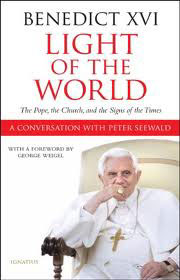 You can find our more at igantius.com the website for Ignatius Press
You can find our more at igantius.com the website for Ignatius Press
Tags: amy welborn, catholic, catholic podcast, catholic prayer, cathollc spirituality, ignatius press, peter seewald, pope benedict, pope benedict xvi
This entry was posted on Tuesday, December 7th, 2010 at 7:28 am
You can follow any responses to this entry through the RSS 2.0 feed.
Going deep into the heart of the Word has never taken on more meaning than when discussing Pope Benedict XVI Apostolic Exhortation “Verbum Domini” (The Word of the Lord). Since the Holy Father is rather busy at this time, the next best person to discuss it with would be Dr. Scott Hahn. Though he too is extraordinarily active, Dr. Hahn took time to to break open this extraordinarily important and beautiful gift for us.
it with would be Dr. Scott Hahn. Though he too is extraordinarily active, Dr. Hahn took time to to break open this extraordinarily important and beautiful gift for us.
[powerpress]
Do what the doctor (Dr. Hahn, of course) has ordered, go to Vatican.va to read and download “Verbum Domini”
Be sure to visit The S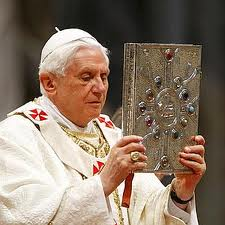 t. Paul Center of Biblical Theology to sign up for free online studies and to learn more “from the heart of the Church”.
t. Paul Center of Biblical Theology to sign up for free online studies and to learn more “from the heart of the Church”.
Tags: catholic, catholic podcast, catholic prayer, cathollc spirituality
This entry was posted on Friday, December 3rd, 2010 at 7:05 pm
You can follow any responses to this entry through the RSS 2.0 feed.
“God’s Promises Are Always Greater Than Our Hopes”
VATICAN CITY, DEC. 1, 2010 (vatican.va).- Here is a translation of the address Benedict XVI gave today during the general audience in Paul VI Hall.
Dear Brothers and Sisters,
I still remember with great joy the Apostolic Journey I made in the United Kingdom last September. England is a land that has given birth to a great many distinguished figures who enhanced Church history with their testimony and their teaching. One of them, venerated both in the Catholic Church and in the Anglican Communion, is the mystic Julian of Norwich, of whom I wish to speak this morning.
The — very scant — information on her life in our possession comes mainly from her Revelations of Divine Love in Sixteen Showings, the book in which this kindly and devout woman set down the content of her visions.
It is known that she lived from 1342 until about 1430, turbulent years both for the Church, torn by the schism that followed the Pope’s return to Rome from Avignon, and for the life of the people who were suffering the consequences of a long drawn-out war between the Kingdoms of England and of France. God, however, even in periods of tribulation, does not cease to inspire figures such as Julian of Norwich, to recall people to peace, love and joy.
As Julian herself recounts, in May 1373, most likely on the 13th of that month, she was suddenly stricken with a very serious illness that in three days seemed to be carrying her to the grave. After the priest, who hastened to her bedside, had shown her the Crucified One not only did Julian rapidly recover her health but she received the 16 revelations that she subsequently wrote down and commented on in her book, Revelations of Divine Love.
And it was the Lord himself, 15 years after these extraordinary events, who revealed to
her the meaning of those visions.
“‘Would you learn to see clearly your Lord’s meaning in this thing? Learn it well: Love was his meaning. Who showed it to you? Love…. Why did he show it to you? For Love’…. Thus I was taught that Love was our Lord’s meaning†(Julian of Norwich, Revelations of Divine Love,Chapter 86).
Inspired by divine love, Julian made a radical decision. Like an ancient anchoress, she decided to live in a cell located near the church called after St Julian, in the city of Norwich — in her time an important urban centre not far from London.
She may have taken the name of Julian precisely from that Saint to whom was dedicated the church in whose vicinity she lived for so many years, until her death.
This decision to live as a “recluseâ€, the term in her day, might surprise or even perplex us. But she was not the only one to make such a choice. In those centuries a considerable number of women opted for this form of life, adopting rules specially drawn up, for them, such as the rule compiled by St Aelred of Rievaulx.
The anchoresses or “reclusesâ€, in their cells, devoted themselves to prayer, meditation and study. In this way they developed a highly refined human and religious sensitivity which earned them the veneration of the people. Men and women of every age and condition in need of advice and comfort, would devoutly seek them. It was not, therefore, an individualistic choice; precisely with this closeness to the Lord, Julian developed the ability to be a counsellor to a great many people and to help those who were going through difficulties in this life.
We also know that Julian too received frequent visitors, as is attested by the autobiography of another fervent Christian of her time, Margery Kempe, who went to Norwich in 1413 to receive advice on her spiritual life. This is why, in her lifetime, Julian was called “Dame Julianâ€, as is engraved on the funeral monument that contains her remains. She had become a mother to many.
Men and women who withdraw to live in God’s company acquire by making this decision a great sense of compassion for the suffering and weakness of others. As friends of God, they have at their disposal a wisdom that the world — from which they have distanced themselves — does not possess and they amiably share it with those who knock at their door.
I therefore recall with admiration and gratitude the women and men’s cloistered monasteries. Today more than ever they are oases of peace and hope, a precious treasure for the whole Church, especially since they recall the primacy of God and the importance, for the journey of faith, of constant and intense prayer.
It was precisely in the solitude infused with God that Julian of Norwich wrote her Revelations of Divine Love. Two versions have come down to us, one that is shorter, probably the older, and one that is longer. This book contains a message of optimism based on the certainty of being loved by God and of being protected by his Providence.
In this book we read the following wonderful words: “And I saw full surely that ere God made us he loved us; which love was never lacking nor ever shall be. And in this love he has made all his works; and in this love he has made all things profitable to us; and in this love our life is everlasting… in which love we have our beginning. And all this shall we see in God, without end†(Revelations of Divine Love, Chapter 86).
The theme of divine love recurs frequently in the visions of Julian of Norwich who, with a certain daring, did not hesitate to compare them also to motherly love. This is one of the most characteristic messages of her mystical theology.
The tenderness, concern and gentleness of God’s kindness to us are so great that they remind us, pilgrims on earth, of a mother’s love for her children. In fact the biblical prophets also sometimes used this language that calls to mind the tenderness, intensity and totality of God’s love, which is manifested in creation and in the whole history of salvation that is crowned by the Incarnation of the Son.
God, however, always excels all human love, as the Prophet Isaiah says: “Can a woman forget her sucking child, that she should have no compassion on the son of her womb? Even these may forget, yet I will never forget you†(Is 49:15).
Julian of Norwich understood the central message for spiritual life:
God is love and it is only if one opens oneself to this love, totally and with total trust, and lets it become one’s sole guide in life, that all things are transfigured, true peace and true joy found and one is able to radiate it.
I would like to emphasize another point. The Catechism of the Catholic Church cites the words of Julian of Norwich when it explains the viewpoint of the Catholic faith on an argument that never ceases to be a provocation to all believers (cf. nn. 304-313, 314).
If God is supremely good and wise, why do evil and the suffering of innocents exist? And the Saints themselves asked this very question. Illumined by faith, they give an answer that opens our hearts to trust and hope: in the mysterious designs of Providence, God can draw a greater good even from evil, as Julian of Norwich wrote: “Here I was taught by the grace of God that I should steadfastly hold me in the Faith … and that … I should take my stand on and earnestly believe in … that ‘all manner of thing shall be wellâ€â€™ (The Revelations of Divine Love, Chapter 32).
Yes, dear brothers and sisters, God’s promises are ever greater than our expectations. If we present to God, to his immense love, the purest and deepest desires of our heart, we shall never be disappointed. “And all will be wellâ€, “all manner of things shall be wellâ€: this is the final message that Julian of Norwich transmits to us and that I am also proposing to you today. Many thanks.
Tags: anglican communion, benedict xvi, catholic, catholic podcast, catholic prayer, cathollc spirituality, julian of norwich, mystic, mystic of the Church, mystical experiences, Norwich, women of the middle ages
This entry was posted on Wednesday, December 1st, 2010 at 7:04 pm
You can follow any responses to this entry through the RSS 2.0 feed.
Audio prayer for the Holy Father’s Intentions
DECEMBER
The Experience of Personal Suffering as a Help to Others who Suffer
General: That our personal experience of suffering may be an
occasion for better understanding the situation of unease
and pain which is the lot of many people who are alone, sick
or aged, and stir us all to give them generous help.
Opening Our Doors to Christ
Missionary: That the peoples of the earth may open their doors to Christ
and to His Gospel of peace, brotherhood and justice.
Tags: benedict xvi, catholic, catholic podcast, catholic prayer, cathollc spirituality, holy father, personal experience, prayers
This entry was posted on Wednesday, December 1st, 2010 at 12:22 am
You can follow any responses to this entry through the RSS 2.0 feed.
Going deep into the heart of the Word has never taken on more meaning than when discussing Pope Benedict XVI Apostolic Exhortation “Verbum Domini” (The Word of the Lord). Since the Holy Father is rather busy at this time, the next best person to discuss it with would be Dr. Scott Hahn. Though he too is extraordinarily active, Dr. Hahn took time to to break open this extraordinarily important and beautiful gift for us.
with would be Dr. Scott Hahn. Though he too is extraordinarily active, Dr. Hahn took time to to break open this extraordinarily important and beautiful gift for us.
[powerpress]
Do what the doctor (Dr. Hahn, of course) has ordered, go to Vatican.va to read and download “Verbum Domini”
Be sure to visit The S t. Paul Center of Biblical Theology to sign up for free online studies and to learn more “from the heart of the Church”.
t. Paul Center of Biblical Theology to sign up for free online studies and to learn more “from the heart of the Church”.
Tags: catholic, catholic podcast, catholic prayer, cathollc spirituality
This entry was posted on Monday, November 29th, 2010 at 8:36 am
You can follow any responses to this entry through the RSS 2.0 feed.
Episode 8 – The Papacy: The Apostolic Throne
Roots of the Faith – From the Church Fathers to You with Mike Aquilina, makes clear that just as an acorn grows into a tree and yet remains the same plant, so the Catholic Church is a living organism that has grown from the faith of the earliest Christians into the body of Christ we know today. Hosted by Kris McGregor
makes clear that just as an acorn grows into a tree and yet remains the same plant, so the Catholic Church is a living organism that has grown from the faith of the earliest Christians into the body of Christ we know today. Hosted by Kris McGregor
[powerpress]
Also visit Mike’s “Discerning Hearts†page for more audio downloads and information!
Tags: catholic, catholic podcast, catholic prayer, cathollc spirituality, church fathers, fathers of the church, mike aquilina, papacy
This entry was posted on Saturday, November 27th, 2010 at 9:15 am
You can follow any responses to this entry through the RSS 2.0 feed.
Vatican City –From Pope Benedict’s Wednesday General Audience from vatican.va
Dear Brothers and Sisters,
Today I would like to talk to you about a woman who played an eminent role in the history of the Church: St Catherine of Siena. The century in which she lived — the 14th — was a troubled period in the life of the Church and throughout the social context of Italy and Europe. Yet, even in the most difficult times, the Lord does not cease to bless his People, bringing forth Saints who give a jolt to minds and hearts, provoking conversion and renewal.
Catherine is one of these and still today speaks to us and impels us to walk courageously toward holiness to be ever more fully disciples of the Lord.
Born in Siena in 1347, into a very large family, she died in Rome in 1380. When Catherine was 16 years old, motivated by a vision of St Dominic, she entered the Third Order of the Dominicans, the female branch known as the Mantellate. While living at home, she confirmed her vow of virginity made privately when she was still an adolescent and dedicated herself to prayer, penance and works of charity, especially for the benefit of the sick.
When the fame of her holiness spread, she became the protagonist of an intense activity of spiritual
guidance for people from every walk of life: nobles and politicians, artists and ordinary people, consecrated men and women and religious, including Pope Gregory xi who was living at Avignon in that period and whom she energetically and effectively urged to return to Rome.
She travelled widely to press for the internal reform of the Church and to foster peace among the States. It was also for this reason that Venerable Pope John Paul ii chose to declare her Co-Patroness of Europe: may the Old Continent never forget the Christian roots that are at the origin of its progress and continue to draw from the Gospel the fundamental values that assure justice and harmony.
Like many of the Saints, Catherine knew great suffering. Some even thought that they should not trust her, to the point that in 1374, six years before her death, the General Chapter of the Dominicans summoned her to Florence to interrogate her. They appointed Raymund of Capua, a learned and humble Friar and a future Master General of the Order, as her spiritual guide. Having become her confessor and also her “spiritual sonâ€, he wrote a first complete biography of the Saint. She was canonized in 1461.
The teaching of Catherine, who learned to read with difficulty and learned to write in adulthood, is contained in the Dialogue of Divine Providence or Libro della Divina Dottrina, a masterpiece of spiritual literature, in her Epistolario and in the collection of her Prayers.
Her teaching is endowed with such excellence that in 1970 the Servant of God Paul VI declared her a Doctor of the Church, a title that was added to those of Co-Patroness of the City of Rome — at the wish of Bl. Pius ix — and of Patroness of Italy — in accordance with the decision of Venerable Pius XII.
In a vision that was ever present in Catherine’s heart and mind Our Lady presented her to Jesus who gave her a splendid ring, saying to her: “I, your Creator and Saviour, espouse you in the faith, that you will keep ever pure until you celebrate your eternal nuptials with me in Heaven†(Bl. Raimondo da Capua, S. Caterina da Siena, Legenda maior, n. 115, Siena 1998). This ring was visible to her alone. In this extraordinary episode we see the vital centre of Catherine’s religious sense, and of all authentic spirituality: Christocentrism. For her Christ was like the spouse with whom a relationship of intimacy, communion and faithfulness exists; he was the best beloved whom she loved above any other good. This profound union with the Lord is illustrated by another episode in the life of this outstanding mystic: the exchange of hearts. According to Raymond of Capua who passed on the confidences Catherine received, the Lord Jesus appeared to her “holding in his holy hands a human heart, bright red and shiningâ€. He opened her side and put the heart within her saying: “Dearest daughter, as I took your heart away from you the other day, now, you see, I am giving you mine, so that you can go on living with it for ever†(ibid.). Catherine truly lived St. Paul’s words, “It is no longer I who live, but Christ who lives in me†(Gal 2:20).
Like the Sienese Saint, every believer feels the need to be conformed with the sentiments of the heart of Christ to love God and his neighbour as Christ himself loves. And we can all let our hearts be transformed and learn to love like Christ in a familiarity with him that is nourished by prayer, by meditation on the Word of God and by the sacraments, above all by receiving Holy Communion frequently and with devotion. Catherine also belongs to the throng of Saints devoted to the Eucharist with which I concluded my Apostolic Exhortation Sacramentum Caritatis (cf. n. 94). Dear brothers and sisters, the Eucharist is an extraordinary gift of love that God continually renews to nourish our journey of faith, to strengthen our hope and to inflame our charity, to make us more and more like him.
A true and authentic spiritual family was built up around such a strong and genuine personality; people fascinated by the moral authority of this young woman with a most exalted lifestyle were at times also impressed by the mystical phenomena they witnessed, such as her frequent ecstasies. Many put themselves at Catherine’s service and above all considered it a privilege to receive spiritual guidance from her. They called her “mother†because, as her spiritual children, they drew spiritual nourishment from her. Today too the
Church receives great benefit from the exercise of spiritual motherhood by so many women, lay and consecrated, who nourish souls with thoughts of God, who strengthen the people’s faith and direct Christian life towards ever loftier peaks. “Son, I say to you and call youâ€, Catherine wrote to one of her spiritual sons, Giovanni Sabbatini, a Carthusian, “inasmuch as I give birth to you in continuous prayers and desire in the presence of God, just as a mother gives birth to a son†(Epistolario, Lettera n. 141: To Fr Giovanni de’ Sabbatini). She would usually address the Dominican Fr Bartolomeo de Dominici with these words: “Most beloved and very dear brother and son in Christ sweet Jesusâ€.
Another trait of Catherine’s spirituality is linked to the gift of tears. They express an exquisite, profound sensitivity, a capacity for being moved and for tenderness. Many Saints have had the gift of tears, renewing the emotion of Jesus himself who did not hold back or hide his tears at the tomb of his friend Lazarus and at the grief of Mary and Martha or at the sight of Jerusalem during his last days on this earth. According to Catherine, the tears of Saints are mingled with the blood of Christ, of which she spoke in vibrant tones and with symbolic images that were very effective: “Remember Christ crucified, God and man….. Make your aim the Crucified Christ, hide in the wounds of the Crucified Christ and drown in the blood of the Crucified Christ†(Epistolario, Lettera n. 21: Ad uno il cui nome si tace [to one who remains anonymous]). Here we can understand why, despite her awareness of the human shortcomings of priests, Catherine always felt very great reverence for them: through the sacraments and the word they dispense the saving power of Christ’s Blood. The Sienese Saint always invited the sacred ministers, including the Pope whom she called “sweet Christ on earthâ€, to be faithful to their responsibilities, motivated always and only by her profound and constant love of the Church. She said
before she died: “in leaving my body, truly I have consumed and given my life in the Church and for the Holy Church, which is for me a most unique grace†(Raimondo da Capua, S. Caterina da Siena, Legenda maior, n. 363). Hence we learn from St Catherine the most sublime science: to know and love Jesus Christ and his Church. In the Dialogue of Divine Providence, she describes Christ, with an unusual image, as a bridge flung between Heaven and earth. This bridge consists of three great stairways constituted by the feet, the side and the mouth of Jesus. Rising by these stairways the soul passes through the three stages of every path to sanctification: detachment from sin, the practice of the virtues and of love, sweet and loving union with God.
Dear brothers and sisters, let us learn from St Catherine to love Christ and the Church with courage, intensely and sincerely. Therefore let us make our own St Catherine’s words that we read in the Dialogue of Divine Providence at the end of the chapter that speaks of Christ as a bridge: “out of mercy you have washed us in his Blood, out of mercy you have wished to converse with creatures. O crazed with love! It did not suffice for you to take flesh, but you also wished to die!… O mercy! My heart drowns in thinking of you: for no matter where I turn to think, I find only mercy†(chapter 30, pp. 79-80). Thank you.
Tags: benedict xvi, catherine of siena, catholic, catholic podcast, catholic prayer, cathollc spirituality, mystic, mystic of the Church, mystical experiences, mystical revelations, mystical visions, st dominic, women of the middle ages
This entry was posted on Wednesday, November 24th, 2010 at 6:35 pm
You can follow any responses to this entry through the RSS 2.0 feed.
Part 2 – A very special edition of “Inside the Pages†as we explore Pope Ben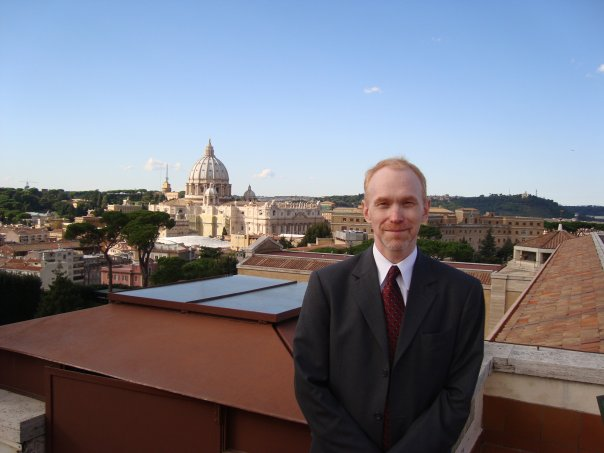 edict’s Apostolic Exhortation, “Verbum Domini†(The Word of the Lord), with Dr. Matthew Bunson. A magnificent gift for the Church, Dr. Bunson breaks open in part 2 of our discussion the liturgy, homelitics and the significance of the document. We encourage you to check out the document yourself by clicking on the links below.
edict’s Apostolic Exhortation, “Verbum Domini†(The Word of the Lord), with Dr. Matthew Bunson. A magnificent gift for the Church, Dr. Bunson breaks open in part 2 of our discussion the liturgy, homelitics and the significance of the document. We encourage you to check out the document yourself by clicking on the links below.
We encourage you to visit the Vatican website so you can read, ponder, and download “Verbum Domini”
[powerpress]
Tags: Apostolic Exhortation, catholic, catholic podcast, catholic prayer, cathollc spirituality, matthew bunson, pope benedict, the liturgy, verbum domini, word of the lord
This entry was posted on Friday, November 19th, 2010 at 7:48 am
You can follow any responses to this entry through the RSS 2.0 feed.
According to the Catholic Encyclopedia, the origins of Corpus Christi can be traced to St. Juliana of Mount Cornillon.
From Pope Benedict’s General Audience from vatican.va
Dear Brothers and Sisters,
This morning too I would like to introduce a female figure to you. She is little known but the Church is deeply indebted to her, not only because of the holiness of her life but also because, with her great fervour, she contributed to the institution of one of the most important solemn Liturgies of the year:Â Corpus Christi.
She is St Juliana de Cornillon, also known as St Juliana of Liège. We know several facts about her life, mainly from a Biography that was probably written by a contemporary cleric; it is a collection of various testimonies of people who were directly acquainted with the Saint.
Juliana was born near Liège, Belgium between 1191 and 1192. It is important to emphasize this place because at that time the Diocese of Liège was, so to speak, a true “Eucharistic Upper Roomâ€. Before Juliana, eminent theologians had illustrated the supreme value of the Sacrament of the Eucharist and, again in Liège, there were groups of women generously dedicated to Eucharistic worship and to fervent communion. Guided by exemplary priests, they lived together, devoting themselves to prayer and to charitable works.
Orphaned at the age of five, Juliana, together with her sister Agnes, was entrusted to the care of the Augustinian nuns at the convent and leprosarium of Mont-Cornillon.
She was taught mainly by a sister called “Sapienza†[wisdom], who was in charge of her spiritual development to the time Juliana received the religious habit and thus became an Augustinian nun.
She became so learned that she could read the words of the Church Fathers, of St Augustine and St Bernard in particular, in Latin. In addition to a keen intelligence, Juliana showed a special propensity for contemplation from the outset. She had a profound sense of Christ’s presence, which she experienced by living the Sacrament of the Eucharist especially intensely and by pausing frequently to meditate upon Jesus’ words: “And lo, I am with you always, to the close of the age†(Mt 28:20).
When Juliana was 16 she had her first vision which recurred subsequently several times during her Eucharistic adoration. Her vision presented the moon in its full splendour, crossed diametrically by a dark stripe. The Lord made her understand the meaning of what had appeared to her. The moon symbolized the life of the Church on earth, the opaque line, on the other hand, represented the absence of a liturgical feast for whose institution Juliana was asked to plead effectively: namely, a feast in which believers would be able to adore the Eucharist so as to increase in faith, to advance in the practice of the virtues and to make reparation for offences to the Most Holy Sacrament.
Juliana, who in the meantime had become Prioress of the convent, kept this revelation that had filled her heart with joy a secret for about 20 years. She then confided it to two other fervent adorers of the Eucharist, Blessed Eva, who lived as a hermit, and Isabella, who had joined her at the Monastery of Mont-Cornillon. The three women established a sort of “spiritual alliance†for the purpose of glorifying the Most Holy Sacrament.
They also chose to involve a highly regarded Priest, John of Lausanne, who was a canon of the Church of St Martin in Liège. They asked him to consult theologians and clerics on what was important to them. Their affirmative response was encouraging.
What happened to Juliana of Cornillon occurs frequently in the lives of Saints. To have confirmation that an inspiration comes from God it is always necessary to be immersed in prayer to wait patiently, to seek friendship and exchanges with other good souls and to submit all things to the judgement of the Pastors of the Church.
It was in fact Bishop Robert Torote, Liège who, after initial hesitation, accepted the proposal of Juliana and her companions and first introduced the Solemnity of Corpus Christi in his diocese. Later other Bishops following his example instituted this Feast in the territories entrusted to their pastoral care.
However, to increase their faith the Lord often asks Saints to sustain trials. This also happened to Juliana who had to bear the harsh opposition of certain members of the clergy and even of the superior on whom her monastery depended.
Of her own free will, therefore, Juliana left the Convent of Mont-Cornillon with several companions. For 10 years — from 1248 to 1258 — she stayed as a guest at various monasteries of Cistercian sisters.
She edified all with her humility, she had no words of criticism or reproach for her adversaries and continued zealously to spread Eucharistic worship.
She died at Fosses-La-Ville, Belgium, in 1258. In the cell where she lay the Blessed Sacrament was exposed and, according to her biographer’s account, Juliana died contemplating with a last effusion to love Jesus in the Eucharist whom she had always loved, honoured and adored. Jacques Pantaléon of Troyes was also won over to the good cause of the Feast of Corpus Christi during his ministry as Archdeacon in Lièges. It was he who, having become Pope with the name of Urban iv in 1264, instituted the Solemnity of Corpus Christi on the Thursday after Pentecost as a feast of precept for the universal Church.
In the Bull of its institution, entitled Transiturus de hoc mundo, (11 Aug. 1264), Pope Urban even referred discreetly to Juliana’s mystical experiences, corroborating their authenticity. He wrote: “Although the Eucharist is celebrated solemnly every day, we deem it fitting that at least once a year it be celebrated with greater honour and a solemn commemoration.
“Indeed we grasp the other things we commemorate with our spirit and our mind, but this does not mean that we obtain their real presence. On the contrary, in this sacramental commemoration of Christ, even though in a different form, Jesus Christ is present with us in his own substance. While he was about to ascend into Heaven he said ‘And lo, I am with you always, to the close of the age’ (Matthew 28:20)â€.
The Pontiff made a point of setting an example by celebrating the solemnity of Corpus Christi in Orvieto, the town where he was then residing. Indeed, he ordered that the famous Corporal with the traces of the Eucharistic miracle which had occurred in Bolsena the previous year, 1263, be kept in Orvieto Cathedral — where it still is today.
While a priest was consecrating the bread and the wine he was overcome by strong doubts about the Real Presence of the Body and Blood of Christ in the sacrament of the Eucharist. A few drops of blood began miraculously to ooze from the consecrated Host, thereby confirming what our faith professes.
Urban iv asked one of the greatest theologians of history, St Thomas Aquinas — who at that time was accompanying the Pope and was in Orvieto — to compose the texts of the Liturgical Office for this great feast. They are masterpieces, still in use in the Church today, in which theology and poetry are fuse. These texts pluck at the heartstrings in an expression of praise and gratitude to the Most Holy Sacrament, while the mind, penetrating the mystery with wonder, recognizes in the Eucharist the Living and Real Presence of Jesus, of his Sacrifice of love that reconciles us with the Father, and gives us salvation.
Although after the death of Urban iv the celebration of the Feast of Corpus Christi was limited to certain regions of France, Germany, Hungary and Northern Italy, it was another Pontiff, John xxii, who in 1317 re-established it for the universal Church. Since then the Feast experienced a wonderful development and is still deeply appreciated by the Christian people.
I would like to affirm with joy that today there is a “Eucharistic springtime†in the Church: How many people pause in silence before the Tabernacle to engage in a loving conversation with Jesus! It is comforting to know that many groups of young people have rediscovered the beauty of praying in adoration before the Most Blessed Sacrament.
I am thinking, for example, of our Eucharistic adoration in Hyde Park, London. I pray that this Eucharistic “springtime†may spread increasingly in every parish and in particular in Belgium, St Juliana’s homeland.
Venerable John Paul II said in his Encyclical Ecclesia de Eucharistia: “In many places, adoration of the Blessed Sacrament is also an important daily practice and becomes an inexhaustible source of holiness. The devout participation of the faithful in the Eucharistic procession on the Solemnity of the Body and Blood of Christ is a grace from the Lord which yearly brings joy to those who take part in it. Other positive signs of Eucharistic faith and love might also be mentioned†(n. 10).
In  remembering St Juliana of Cornillon let us also renew our faith in the Real Presence of Christ in the Eucharist. As we are taught by the Compendium of the Catechism of the Catholic Church,“Jesus Christ is present in the Eucharist in a unique and incomparable way. He is present in a true, real and substantial way, with his Body and his Blood, with his Soul and his Divinity. In the Eucharist, therefore, there is present in a sacramental way, that is, under the Eucharistic Species of bread and wine, Christ whole and entire, God and Man†(n. 282).
Dear friends, fidelity to the encounter with the Christ in the Eucharist in Holy Mass on Sunday is essential for the journey of faith, but let us also seek to pay frequent visits to the Lord present in the Tabernacle! In gazing in adoration at the consecrated Host, we discover the gift of God’s love, we discover Jesus’ Passion and Cross and likewise his Resurrection. It is precisely through our gazing in adoration that the Lord draws us towards him into his mystery in order to transform us as he transforms the bread and the wine.
The Saints never failed to find strength, consolation and joy in the Eucharistic encounter. Let us repeat before the Lord present in the Most Blessed Sacrament the words of the Eucharistic hymn “Adoro te devoteâ€: [Devoutly I adore Thee]: Make me believe ever more in you, “Draw me deeply into faith, / Into Your hope, into Your loveâ€.
Thank you.
Tags: catholic, catholic podcast, catholic prayer, cathollc spirituality, corpus christi, feast of corpus christi, feast of the blessed sacrament, saint augustine
This entry was posted on Wednesday, November 17th, 2010 at 5:33 pm
You can follow any responses to this entry through the RSS 2.0 feed.
A very special edition of “Inside the Pages” as we explore Pope Ben edict’s Apostolic Exhortation, “Verbum Domini” (The Word of the Lord), with Dr. Matthew Bunson. A magnificent gift for the Church, Dr. Bunson breaks open in part 1 of our discussion the significance of the document and how it was comprised. We encourage you to check out the document yourself by clicking on the links below.
edict’s Apostolic Exhortation, “Verbum Domini” (The Word of the Lord), with Dr. Matthew Bunson. A magnificent gift for the Church, Dr. Bunson breaks open in part 1 of our discussion the significance of the document and how it was comprised. We encourage you to check out the document yourself by clicking on the links below.
[powerpress]
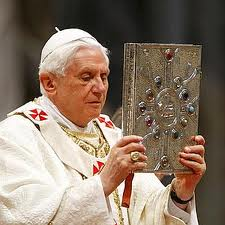 POST-SYNODAL
POST-SYNODALAPOSTOLIC EXHORTATION
VERBUM DOMINI
OF THE HOLY FATHER
BENEDICT XVI
TO THE BISHOPS, CLERGY,
CONSECRATED PERSONS
AND THE LAY FAITHFUL
ON THE WORD OF GOD
IN THE LIFE AND MISSION
OF THE CHURCH
That our joy may be complete [2]
From “Dei Verbum†to the Synod on the Word of God [3]
The Synod of Bishops on the Word of God [4]
The Prologue of John’s Gospel as a guide [5]
God in dialogue [6]
The analogy of the word of God [7]
The cosmic dimension of the word [8]
The creation of man [9]
The realism of the word [10]
Christology of the word [11-13]
The eschatological dimension of the word of God [14]
The word of God and the Holy Spirit [15-16]
Tradition and Scripture [17-18]
Sacred Scripture, inspiration and truth [19]
God the Father, source and origin of the word [20-21]
Our Response To The God Who Speaks
Called to the covenant with God [22]
God hears us and responds to our questions [23]
In dialogue with God through his words [24]
The word of God and faith [25]
Sin as a refusal to hear the word of God [26]
Mary, “Mother of God’s Word†and “Mother of Faith†[27-28]
The Interpretation Of Sacred Scripture In The Church
The Church as the primary setting for biblical hermeneutics [29-30]
“The soul of sacred theology†[31]
The development of biblical studies and the Church’s magisterium [32-33]
The Council’s biblical hermeneutic: a directive to be appropriated [34]
The danger of dualism and a secularized hermeneutic [35]
Faith and reason in the approach to Scripture [36]
Literal sense and spiritual sense [37]
The need to transcend the “letter†[38]
The Bible’s intrinsic unity [39]
The relationship between the Old and the New Testaments [40-41]
The “dark†passages of the Bible [42]
Christians, Jews and the sacred Scriptures [43]
The fundamentalist interpretation of sacred Scripture [44]
Dialogue between pastors, theologians and exegetes [45]
The Bible and ecumenism [46]
Consequences for the study of theology [47]
The saints and the interpretation of Scripture [48-49]
The Word Of God And The Church
The Church receives the word [50]
Christ’s constant presence in the life of the Church [51]
The Liturgy, Privileged Setting For The Word Of God
The word of God in the sacred liturgy [52]
Sacred Scripture and the sacraments [53]
The word of God and the Eucharist [54-55]
The sacramentality of the word [56]
Sacred Scripture and the Lectionary [57]
Proclamation of the word and the ministry of Reader [58]
The importance of the homily [59]
The fittingness of a Directory on Homiletics [60]
The word of God, Reconciliation and the Anointing of the Sick [61]
The word of God and the Liturgy of the Hours [62]
The word of God and the Book of Blessings [63]
Suggestions and practical proposals for promoting fuller participation in the liturgy [64]a) Celebrations of the word of God [65]
b) The word and silence [66]
c) The solemn proclamation of the word of God [67]
d) The word of God in Christian Churches [68]
e) The exclusive use of biblical texts in the liturgy [69]
f) Biblically-inspired liturgical song [70]
g) Particular concern for the visually and hearing impaired [71]
The Word Of God In The Life Of The Church
Encountering the word of God in sacred Scripture [72]
Letting the Bible inspire pastoral activity [73]
The biblical dimension of catechesis [74]
The biblical formation of Christians [75]
Sacred Scripture in large ecclesial gatherings [76]
The word of God and vocations [77]a) Ordained ministers and the word of God [78-81]
b) The word of God and candidates for Holy Orders [82]
c) The word of God and the consecrated life [83]
d) The word of God and the lay faithful [84]
e) The word of God, marriage and the family [85]The prayerful reading of sacred Scripture and “lectio divina†[86-87]
The word of God and Marian prayer [88]
The word of God and the Holy Land [89]
The Church’s Mission: To Proclaim The Word Of God To The World
The Word from the Father and to the Father [90]
Proclaiming to the world the “Logos†of hope [91]
The word of God is the source of the Church’s mission [92]
The word and the Kingdom of God [93]
All the baptized are responsible for this proclamation [94]
The necessity of the “missio ad gentes†[95]
Proclamation and the new evangelization [96]
The word of God and Christian witness [97-98]
The Word Of God And Commitment In The World
Serving Jesus in “the least of his brethren†(Mt 25:40) [99]
The word of God and commitment to justice in society [100-101]
The proclamation of God’s word, reconciliation and peace between peoples [102]
The word of God and practical charity [103]
The proclamation of the word of God and young people [104]
The proclamation of the word of God and migrants [105]
The proclamation of the word of God and the suffering [106]
The proclamation of the word of God and the poor [107]
The proclamation of the word of God and the protection of creation [108]
The value of culture for the life of humanity [109]
The Bible, a great code for cultures [110]
Knowledge of the Bible in schools and universities [111]
Sacred Scripture in the variety of artistic expressions [112]
The word of God and the means of social communication [113]
The Bible and inculturation [114]
Translating the Bible and making it more widely available [115]
God’s word transcends cultural limits [116]
The Word Of God And Interreligious Dialogue
The value of interreligious dialogue [117]
Dialogue between Christians and Muslims [118]
Dialogue with other religions [119]
Dialogue and religious freedom [120]
God’s definitive word [121]
New evangelization and a new hearing [122]
The word and joy [123]
“Mater Verbi et Mater laetitiae†[124]
Tags: catholic, catholic podcast, catholic prayer, cathollc spirituality, sacred scripture
This entry was posted on Monday, November 15th, 2010 at 7:56 am
You can follow any responses to this entry through the RSS 2.0 feed.
Episode 7 – The Clergy – Love’s Earthly Form
Roots of the Faith – From the Church Fathers to You with Mike Aquilina, makes clear that just as an acorn grows into a tree and yet remains the same plant, so the Catholic Church is a living organism that has grown from the faith of the earliest Christians into the body of Christ we know today. Hosted by Kris McGregor
makes clear that just as an acorn grows into a tree and yet remains the same plant, so the Catholic Church is a living organism that has grown from the faith of the earliest Christians into the body of Christ we know today. Hosted by Kris McGregor
[powerpress]
Also visit Mike’s “Discerning Hearts†page for more audio downloads and information!
Tags: catholic, catholic podcast, catholic prayer, cathollc spirituality, church fathers, holy orders, kris mcgregor, mike aquilina, servant books
This entry was posted on Saturday, November 13th, 2010 at 5:25 am
You can follow any responses to this entry through the RSS 2.0 feed.
Episode 6 – Purgatory: Love Stronger than Death
Roots of the Faith – From the Church Fathers to You with Mike Aquilina, makes clear that just as an acorn grows into a tree and yet remains the same plant, so the Catholic Church is a living organism that has grown from the faith of the earliest Christians into the body of Christ we know today. Hosted by Kris McGregor
makes clear that just as an acorn grows into a tree and yet remains the same plant, so the Catholic Church is a living organism that has grown from the faith of the earliest Christians into the body of Christ we know today. Hosted by Kris McGregor
[powerpress]
Also visit Mike’s “Discerning Hearts†page for more audio downloads and information!
Tags: catholic, catholic podcast, catholic prayer, cathollc spirituality, church fathers, kris mcgregor, mike aquilina, purgatory
This entry was posted on Friday, November 5th, 2010 at 6:22 pm
You can follow any responses to this entry through the RSS 2.0 feed.
From Pope Benedict’s General Audience from vatican.va
With Marguerite d’Oingt, of whom I would like to speak to you today, we are introduced to Carthusian spirituality which draws its inspiration from the evangelical synthesis lived and proposed by St Bruno. We do not know the date of her birth, although some place it around 1240. Marguerite came from a powerful family of the old nobility of Lyons, the Oingt. We know that her mother was also called Marguerite, that she had two brothers — Giscard and Louis — and three sisters: Catherine, Elizabeth and Agnes. The latter followed her to the Carthusian monastery, succeeding her as Prioress.
We have no information on her childhood, but from her writings it seems that she spent it peacefully in an affectionate family environment. In fact, to express God’s boundless love, she valued images linked to the family, with particular reference to the figure of the father and of the mother. In one of her meditations she prays thus: “Most gentle Lord, when I think of the special graces that you have given me through your solicitude: first of all, how you took care of me since my childhood and how you removed me from the danger of this world and called me to dedicate myself to your holy service, and how you provided everything that was necessary for me: food, drink, dress and footwear (and you did so) in such a way that I had no occasion to think of these things but of your great mercy†(Marguerite d’Oingt, Scritti Spirituali, Meditazione V, 100, Cinisello Balsamo, 1997, p. 74).
Again from her meditations we know that she entered the Carthusian monastery of Poleteins in response to the Lord’s call, leaving everything behind and accepting the strict Carthusian Rule in order to belong totally to the Lord, to be with him always. She wrote: “Gentle Lord, I left my father and my mother and my siblings and all the things of this world for love of you; but this is very little, because the riches of this world are but thorns that prick; and the more one possesses the more unfortunate one is. And because of this it seems to me that I left nothing other than misery and poverty; but you know, gentle Lord, that if I possessed a gentle thousand worlds and could dispose of them as I pleased, I would abandon everything for love of you; and even if you gave me everything that you possess in Heaven and on earth, I would not consider myself satiated until I had you, because you are the life of my soul, I do not have and do not want to have a father and mother outside of you†(ibid., Meditazione II, 32, p. 59).
We also have little data on her life in the Carthusian monastery. We know that in 1288 she became its fourth Prioress, a post she held until her death, 11 February 1310. From her writings, however, we do not deduce particular stages in her spiritual itinerary. She conceived the entirety of life as a journey of purification up to full configuration with Christ. He is the book that is written, which is inscribed daily in her own heart and life, in particular his saving Passion. In the work “Speculumâ€, referring to herself in the third person Marguerite stresses that by the Lord’s grace “she had engraved in her heart the holy life that Jesus Christ God led on earth, his good example and his good doctrine. She had placed the gentle Jesus Christ so well in her heart that it even seemed to her that he was present and that he had a closed book in his hand, to instruct her†(ibid., I, 2-3, p. 81). “In this book she found written the life that Jesus Christ led on earth, from his birth to his ascension into Heaven†(ibid., I, 12, p. 83). Every day, beginning in the morning, Marguerite dedicated herself to the study of this book. And, when she had looked at it well, she began to read the book of her own conscience, which showed the falsehoods and lies of her own life (cf. ibid., I, 6-7, p. 82); she wrote about herself to help others and to fix more deeply in her heart the grace of the presence of God, so as to make every day of her life marked by comparison with the words and actions of Jesus, with the Book of his life. And she did this so that Christ’s life would be imprinted in her soul in a permanent and profound way, until she was able to see the Book internally, that is, until contemplating the mystery of God Trinity (cf. ibid., II, 14-22; III, 23-40, pp. 84-90).
Through her writings, Marguerite gives us some traces of her spirituality, enabling us to understand some features of her personality and of her gifts of governance. She was a very learned woman; she usually wrote in Latin, the language of the erudite, but she also wrote in Provençal, and this too is a rarity: thus her writings are the first of those known to be written in that language. She lived a life rich in mystical experiences described with simplicity, allowing one to intuit the ineffable mystery of God, stressing the limits of the mind to apprehend it and the inadequacy of human language to express it. Marguerite had a linear personality, simple, open, of gentle affectivity, great balance and acute discernment, able to enter into the depths of the human spirit, discerning its limits, its ambiguities, but also its aspirations, the soul’s élan toward God. She showed an outstanding aptitude for governance, combining her profound mystical spiritual life with service to her sisters and to the community. Significant in this connection is a passage of a letter to her father. She wrote: “My dear father, I wish to inform you that I am very busy because of the needs of our house, so that I am unable to apply my mind to good thoughts; in fact, I have so much to do that I do not know which way to turn. We did not harvest the wheat in the seventh month of the year and our vineyards were destroyed by the storm. Moreover, our church is in such a sorry state that we are obliged to reconstruct it in part†(ibid., Lettere, III, 14, p. 127).
A Carthusian nun thus describes the figure of Marguerite: “Revealed through her work is a fascinating personality, of lively intelligence, oriented to speculation and at the same time favoured by mystical graces: in a word, a holy and wise woman who is able to express with a certain humour an affectivity altogether spiritual†(Una Monaca Certosina; Certosine, in the Dizionario degli Istituti di Perfezione, Rome, 1975, col. 777). In the dynamism of mystical life, Marguerite valued the experience of natural affections, purified by grace, as a privileged means to understand more profoundly and to second divine action with greater alacrity and ardour. The reason lies in the fact that the human person is created in the image of God and is therefore called to build with God a wonderful history of love, allowing himself to be totally involved in his initiative.
The God-Trinity, the God-love who reveals himself in Christ fascinated her, and Marguerite lived a relationship of profound love for the Lord and, in contrast, sees human ingratitude to the point of betrayal, even to the paradox of the Cross. She says that the Cross of Christ is similar to the bench of travail. Jesus’ pain is compared with that of a mother. She wrote: “The mother who carried me in her womb suffered greatly in giving birth to me, for a day or a night, but you, most gentle Lord, were tormented for me not only for one night or one day, but for more than 30 years!… How bitterly you suffered because of me throughout your life! And when the moment of delivery arrived, your work was so painful that your holy sweat became as drops of blood which ran down your whole body to the ground” (ibid., Meditazione I, 33, p. 59).
In evoking the accounts of Jesus’ Passion, Marguerite contemplated these sorrows with profound compassion. She said: “You were placed on the hard bed of the Cross, so that you could not move or turn or shake your limbs as a man usually does when suffering great pain, because you were completely stretched and pierced with the nails… and… all your muscles and veins were lacerated…. But all these pains… were still not sufficient for you, so much so that you desired that your side be pierced so cruelly by the lance that your defenceless body should be totally ploughed and torn and your precious blood spurted with such violence that it formed a long path, almost as if it were a currentâ€. Referring to Mary, she said: “It was no wonder that the sword that lacerated your body also penetrated the heart of your glorious Mother who so wanted to support you… because your love was loftier than any other love†(ibid., Meditazione II, 36-39.42, p. 60f).
Dear friends, Marguerite d’Oingt invites us to meditate daily on the life of sorrow and love of Jesus and that of his mother, Mary. Here is our hope, the meaning of our existence. From contemplation of Christ’s love for us are born the strength and joy to respond with the same love, placing our life at the service of God and of others. With Marguerite we also say: “Gentle Lord, all that you did, for love of me and of the whole human race, leads me to love you, but the remembrance of your most holy Passion gives unequalled vigour to my power of affection to love you. That is why it seems to me that… I have found what I so much desired: not to love anything other than you or in you or for love of you†(ibid., Meditazione II, 46, p. 62).
At first glance this figure of a Medieval Carthusian nun, as well as her life and her thought, seems distant from us, from our life, from our way of thinking and acting. But if we look at the essential aspect of this life we see that it also affects us and that it would also become the essential aspect of our own existence.
We have heard that Marguerite considered the Lord as a book, she fixed her gaze on the Lord, she considered him a mirror in which her own conscience also appeared. And from this mirror light entered her soul. She let into their own being the word, the life of Christ and thus she was transformed; her conscience was enlightened, she found criteria and light and was cleansed. It is precisely this that we also need: to let the words, life and light of Christ enter our conscience so that it is enlightened, understands what is true and good and what is wrong; may our conscience be enlightened and cleansed. Rubbish is not only on different streets of the world. There is also rubbish in our consciences and in our souls. Only the light of the Lord, his strength and his love, cleanses us, purifies us, showing us the right path. Therefore let us follow holy Marguerite in this gaze fixed on Jesus. Let us read the book of his life, let us allow ourselves to be enlightened and cleansed, to learn the true life. Thank you.
Marguerite D’Oingt was born in 1240.  She was born to noble parents in the French Beaujolais region. By 1288, she became prioress of the Carthusian …aka St. Bruno monastery of Poletains at Lyon. Although she was never canonized, a popular cult in her honor flourished until the Revolution, and she was revered as blessed. Marguerite is the only medieval Carthusian woman writer known to us. The Pagina meditationum, a response in Latin to a visionary experience during Mass, interweaves liturgical sections with reflections on Christ’s Passion and the Last Judgment. In a remarkable passage, Marguerite develops the image of Christ as a woman undergoing the suffering of labor. The Speculum, written in Franco-Provençal and dedicated to Hugo, prior of Vallebonne, describes three visions and their meaning. In the first, Christ shows her a book with white, black, red, and golden letters symbolizing his suffering. In the second, the book opens and reveals a vision of Paradise and the heavens, whence all goodness emanates. In the third, she is shown the glorified body of Christ and meditates on its meaning for Christian spirituality.
From the “Speculum” (latin for mirror)
[To help her reader, Marguerite will tell how this “person of my acquaintance” progressed in her ability to meditate. First she imagined Christ standing before her with a closed book in his hand; she could look at the cover but not at the inside until she has first studied the books of the humanity of Jesus and of her own conscience. She tried to think of God in heaven:]
But she always had to return to the beginning of the life that our Lord Jesus Christ led on earth, until she had amended her life, based on the example of this book. In this way, she meditated for a long time. [p.43]
[After “a long time” she sees the closed book held by Christ opening:]
The inside of this book was like a beautiful mirror, and there were only two pages. Of the things she saw in this book I will tell you only little, for I have neither the understanding that could conceive it, nor the mouth that could tell it. Nevertheless, I will tell you some of it, if God gives my the grace to do it.      [p.43]
[The pages of the opened book reflected the angels and saints in heaven, whose happiness Marguerite describes. Finally she imagined herself seeing the glorified Christ:]
And right away her heart was so ravished that she thought she was in a place much larger than the entire world, and more brilliant all over than the sun; and it was full of such beautiful and glorious people that no human mouth could tell of it.
Among others, she seemed to see Jesus Christ, so glorious that no human heart could conceive of it. He was clothed in this glorious garment which he assumed in the noble body of Our Lady. On His noble hands and feet appeared the glorious wounds that He suffered for love of us. From these glorious wounds poured forth such a great light that one was stunned by it; it was as if all the beauty of the Divinity was passed on through it.
This glorious body was so noble and so transparent that one could see clearly the soul inside of it. This body was so noble that one could see oneself reflected in it, more clearly than in a mirror. This body was so beautiful that one could see the angels and the saints, as if they were painted on it…. [p.45]
[She invites her reader to visualize the scene — right now — and to consider the results of such visualization:]
Now imagine His great beauty, so great that He has given to all the angels and all the saints who are His members, the gift of being as brilliant as the sun. You can imagine how beautiful the place is where there are so many brilliant lights….
Now you can imagine the great goodness that is in Him who has thus given everything He has to His friends. He did even more for them, for He has given Himself. He made them so beautiful and so glorious that each of them sees the Trinity in himself, as one sees in a beautiful mirror that which is in front of it….
And just as the saints take pleasure in seeing the beauty of Our Lord, so our good Creator takes pleasure in the beauty and love of the beautiful creatures He has made in His image and semblance: thus a good master likes to look at a beautiful painting when he has painted it well.
I truly believe that there is not a heart in this world so cold that it would not be set on fire with love, if it could imagine and know the very great beauty of Our Lord.     [pp.45-47]
Tags: catholic, catholic podcast, catholic prayer, cathollc spirituality, contemplation, mystic, mystic of the Church, pope benedict, sufferings of christ, women of the middle ages
This entry was posted on Wednesday, November 3rd, 2010 at 4:03 pm
You can follow any responses to this entry through the RSS 2.0 feed.
Be sure to visit the St. Bridget Discerning Hearts page!!!
And here is an earlier Discerning Hearts post on St. Bridget!
Vatican City, Oct 27, 2010 Pope Benedict’s General Audience from vatican.va
Saint Bridget of Sweden
Dear Brothers and Sisters,
On the eve of the Great Jubilee in anticipation of the Year 2000 the Venerable Servant of God John Paul II proclaimed St Bridget of Sweden Co-Patroness of the whole of Europe. This morning I would like to present her, her message and the reasons why — still today — this holy woman has much to teach the Church and the world.
We are well acquainted with the events of St Bridget’s life because her spiritual fathers compiled her biography in order to further the process of her canonization immediately after her death in 1373. Bridget was born 70 years earlier, in 1303, in Finster, Sweden, a Northern European nation that for three centuries had welcomed the Christian faith with the same enthusiasm as that with which the Saint had received it from her parents, very devout people who belonged to noble families closely related to the reigning house.
We can distinguished two periods in this Saint’s life.
The first was characterized by her happily married state. Her husband was called Ulf and he was Governor of an important district of the Kingdom of Sweden. The marriage lasted for 28 years, until Ulf’s death. Eight children were born, the second of whom, Karin (Catherine), is venerated as a Saint. This is an eloquent sign of Bridget’s dedication to her children’s education. Moreover, King Magnus of Sweden so appreciated her pedagogical wisdom that he summoned her to Court for a time, so that she could introduce his young wife, Blanche of Namur, to Swedish culture. Bridget, who was given spiritual guidance by a learned religious who initiated her into the study of the Scriptures, exercised a very positive influence on her family which, thanks to her presence, became a true “domestic churchâ€. Together with her husband she adopted the Rule of the Franciscan Tertiaries. She generously practiced works of charity for the poor; she also founded a hospital. At his wife’s side Ulf’s character improved and he advanced in the Christian life. On their return from a long pilgrimage to Santiago de Compostela, which they made in 1341 with other members of the family, the couple developed a project of living in continence; but a little while later, in the tranquillity of a monastery to which he had retired, Ulf’s earthly life ended. This first period of Bridget’s life helps us to appreciate what today we could describe as an authentic “conjugal spiritualityâ€: together, Christian spouses can make a journey of holiness sustained by the grace of the sacrament of Marriage. It is often the woman, as happened in the life of St Bridget and Ulf, who with her religious sensitivity, delicacy and gentleness succeeds in persuading her husband to follow a path of faith. I am thinking with gratitude of the many women who, day after day, illuminate their families with their witness of Christian life, in our time too. May the Lord’s Spirit still inspire holiness in Christian spouses today, to show the world the beauty of marriage lived in accordance with the Gospel values: love, tenderness, reciprocal help, fruitfulness in begetting and in raising children, openness and solidarity to the world and participation in the life of the Church.
The second period of Bridget’s life began when she was widowed. She did not consider another marriage in order to deepen her union with the Lord through prayer, penance and charitable works. Therefore Christian widows too may find in this Saint a model to follow. In fact, upon the death of her husband, after distributing her possessions to the poor — although she never became a consecrated religious — Bridget settled near the Cistercian Monastery of Alvastra. Here began the divine revelations that were to accompany her for the rest of her life. Bridget dictated them to her confessors-secretaries, who translated them from Swedish into Latin and gathered them in eight volumes entitled Revelationes (Revelations). A supplement followed these books called, precisely,Revelationes extravagantes (Supplementary revelations).
St Bridget’s Revelations have a very varied content and style. At times the revelations are presented in the form of dialogues between the divine Persons, the Virgin, the Saints and even demons; they are dialogues in which Bridget also takes part. At other times, instead, a specific vision is described; and in yet others what the Virgin Mary reveals to her concerning the life and mysteries of the Son.
The value of St Bridget’s Revelations, sometimes the object of criticism Venerable John Paul II explained in his Letter Spes Aedificandi: “The Church, which recognized Bridget’s holiness without ever pronouncing on her individual revelations, has accepted the overall authenticity of her interior experience†(n. 5). Indeed, reading these Revelations challenges us on many important topics. For example, the description of Christ’s Passion, with very realistic details, frequently recurs. Bridget always had a special devotion to Christ’s Passion, contemplating in it God’s infinite love for human beings. She boldly places these words on the lips of the Lord who speaks to her: “O my friends, I love my sheep so tenderly that were it possible I would die many other times for each one of them that same death I suffered for the redemption of all†(Revelationes, Book I, c. 59). The sorrowful motherhood of Mary, which made her Mediatrix and Mother of Mercy, is also a subject that recurs frequently in the Revelations.
In receiving these charisms, Bridget was aware that she had been given a gift of special love on the Lord’s part: “My Daughter†— we read in the First Book of Revelations — “I have chosen you for myself, love me with all your heart… more than all that exists in the world†(c. 1). Bridget, moreover, knew well and was firmly convinced that every charism is destined to build up the Church. For this very reason many of her revelations were addressed in the form of admonishments, even severe ones, to the believers of her time, including the Religious and Political Authorities, that they might live a consistent Christian life; but she always reprimanded them with an attitude of respect and of full fidelity to the Magisterium of the Church and in particular to the Successor of the Apostle Peter.
In 1349 Bridget left Sweden for good and went on pilgrimage to Rome. She was not only intending to take part in the Jubilee of the Year 1350 but also wished to obtain from the Pope approval for the Rule of a Religious Order that she was intending to found, called after the Holy Saviour and made up of monks and nuns under the authority of the Abbess. This is an element we should not find surprising: in the Middle Ages monastic foundations existed with both male and female branches, but with the practice of the same monastic Rule that provided for the Abbess’ direction. In fact, in the great Christian tradition the woman is accorded special dignity and — always based on the example of Mary, Queen of Apostles — a place of her own in the Church, which, without coinciding with the ordained priesthood is equally important for the spiritual growth of the Community. Furthermore, the collaboration of consecrated men and women, always with respect for their specific vocation, is of great importance in the contemporary world. In Rome, in the company of her daughter Karin, Bridget dedicated herself to a life of intense apostolate and prayer. And from Rome she went on pilgrimage to various Italian Shrines, in particular to Assisi, the homeland of St Francis for whom Bridget had always had great devotion. Finally, in 1371, her deepest desire was crowned: to travel to the Holy Land, to which she went accompanied by her spiritual children, a group that Bridget called “the friends of Godâ€. In those years the Pontiffs lived at Avignon, a long way from Rome: Bridget addressed a heartfelt plea to them to return to the See of Peter, in the Eternal City. She died in 1373, before Pope Gregory XI returned to Rome definitively. She was buried temporarily in the Church of San Lorenzo in Panisperna in Rome but in 1374 her children, Birger and Karin, took her body back to her homeland, to the Monastery of Vadstena, the headquarters of the Religious Order St Bridget had founded. The order immediately experienced a considerable expansion. In 1391 Pope Boniface IX solemnly canonized her. Bridget’s holiness, characterized by the multiplicity of her gifts and the experiences that I have wished to recall in this brief biographical and spiritual outline, makes her an eminent figure in European history. In coming from Scandinavia, St Bridget bears witness to the way Christianity had deeply permeated the life of all the peoples of this Continent. In declaring her Co-Patroness of Europe, Pope John Paul II hoped that St Bridget — who lived in the 14th century when Western Christianity had not yet been wounded by division — may intercede effectively with God to obtain the grace of full Christian unity so deeply longed for.
Let us pray, dear brothers and sisters, for this same intention, which we have very much at heart, and that Europe may always be nourished by its Christian roots, invoking the powerful intercession of St Bridget of Sweden, a faithful disciple of God and Co-Patroness of Europe. Thank you for your attention.
Tags: Bridget Discerning Hearts, catholic, catholic podcast, catholic prayer, cathollc spirituality, devotion, holy women, love, motherhood, mystic, mystic of the Church, mystical expeeriences, mystical experiences, mystical revelations, pope benedict xvi, st bridget of sweden, St. Bridget, Sweden, women of the middle ages
This entry was posted on Wednesday, October 27th, 2010 at 6:07 pm
You can follow any responses to this entry through the RSS 2.0 feed.

